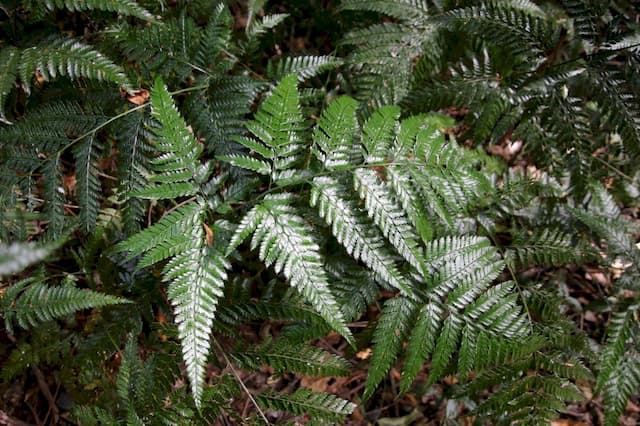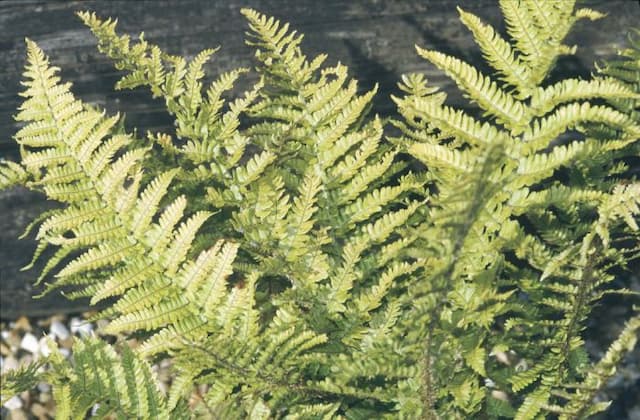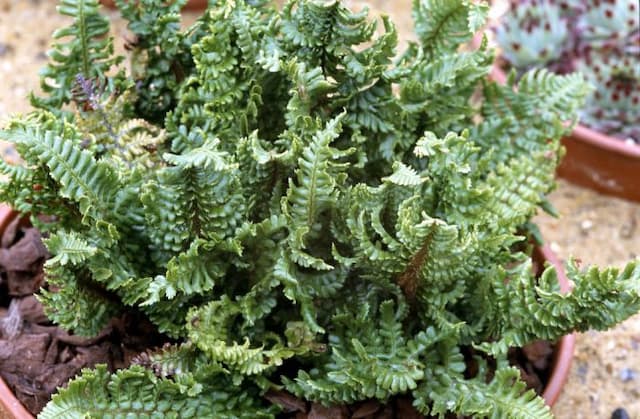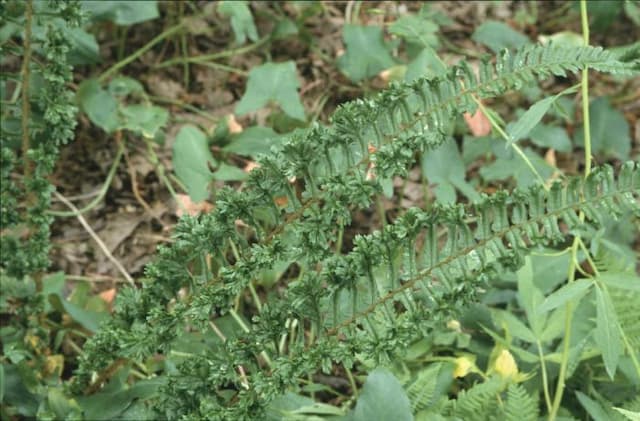Golden Male Fern Dryopteris affinis 'Cristata'

ABOUT
The plant known as Golden Male Fern showcases a lush, green appearance with distinct fronds that exhibit an intricate texture. Each frond splits into numerous leaflets that are elegantly divided, creating a delicate lace-like pattern. The fronds gracefully arch out and upward from a central point, forming a fountain-like shape that adds a dynamic quality to its presence. Notably, the tips of the fronds are crested, giving them a unique and ornamental aspect that resembles a ruffled crest or tuft. This crested feature, found at the tip of each frond and along the leaflet margins, is a hallmark characteristic of this particular variety. The vibrant green color of the fronds remains prominent throughout the growing season, providing a lasting verdant display. Moreover, the fern has a robust and sturdy stance, with the central portion displaying a dense clustering of fronds which taper off elegantly as they radiate outwards.
About this plant
 Names
NamesFamily
Dryopteridaceae
Synonyms
Golden-Scaled Male Fern, Scaly Male Fern, Golden Male Fern
Common names
Dryopteris affinis var. cristata, Dryopteris pseudo-mas var. cristata, Aspidium affine var. cristatum, Nephrodium affine var. cristatum, Lastrea cristata, Lastrea affinis var. cristata.
 Toxicity
ToxicityTo humans
The Golden-scaled male fern is not known to be toxic to humans. Therefore, there are no specific symptoms of poisoning associated with this plant as it is generally considered non-toxic. Ingesting it should not result in any harmful consequences for humans.
To pets
The Golden-scaled male fern is also not known to be toxic to pets. Similar to its effect on humans, ingestion of this plant is not associated with any specific symptoms of poisoning and should not lead to any adverse health effects in pets.
 Characteristics
CharacteristicsLife cycle
Perennials
Foliage type
Evergreen
Color of leaves
Green
Height
2-3 feet (60-90 cm)
Spread
2-3 feet (60-90 cm)
Plant type
Fern
Hardiness zones
5
Native area
Western Europe
Benefits
 General Benefits
General Benefits- Ornamental Value - Dryopteris affinis 'Cristata', commonly known as the Golden Male Fern, boasts unique, crest-like fronds that add texture and visual interest to gardens.
- Shade Tolerance - This fern thrives in shady conditions where other plants might struggle, making it ideal for woodland gardens or shaded borders.
- Low Maintenance - Once established, it requires minimal care beyond the occasional watering during prolonged dry periods, making it suitable for low-maintenance landscapes.
- Deer Resistance - The Golden Male Fern is generally resistant to deer, reducing the need for protective measures in areas with deer populations.
- Soil Stability - The plant's root system can help to stabilize soil, preventing erosion in sloped or delicate areas of the garden.
- Seasonal Interest - It provides year-round interest in mild climates, and in colder regions, the fronds add a lush, green touch throughout the growing season.
- Habitat Support - Ferns like the Golden Male Fern offer habitat and food for a variety of insects, which in turn can attract birds and other wildlife to the garden.
 Medical Properties
Medical PropertiesThis plant is not used for medical purposes.
 Air-purifying Qualities
Air-purifying QualitiesThis plant is not specifically known for air purifying qualities.
 Other Uses
Other Uses- The Golden-scaled male fern can be used in terrariums and vivariums, providing a lush, green background and essential humidity for the inhabitants such as small reptiles or amphibians.
- Due to its attractive foliage, it can serve as a natural backdrop for outdoor photography, where photographers use its dense fronds to create a lush, green environment.
- As a natural dye, the leaves of the Golden-scaled male fern might be used in traditional textile dyeing processes for a green hue.
- This fern can be planted alongside streams or water features to prevent soil erosion with its robust root system.
- The fern can be used in educational settings, such as schools or nature centers, for children to learn about plant life cycles and spore reproduction.
- Golden-scaled male fern can be utilized in floral arrangements as long-lasting greenery, complementing flowers while providing structure and volume.
- This plant can be used as a subtle natural insect repellent when planted around outdoor seating areas as some ferns are known to repel certain insects.
- The fern is ideal for use in creating a "green roof" to provide better insulation and reduce rainwater runoff in urban areas.
- In artistic installations, both live and dried fronds of the Golden-scaled male fern can be used as part of botanical sculptures or displays.
- For hobbyists in model railroading or diorama building, the smaller fronds of this fern can be incorporated into miniature landscapes to resemble trees or bushes.
Interesting Facts
 Feng Shui
Feng ShuiThe Golden Male Fern is not used in Feng Shui practice.
 Zodiac Sign Compitability
Zodiac Sign CompitabilityThe Golden Male Fern is not used in astrology practice.
 Plant Symbolism
Plant Symbolism- Resilience: As a species of fern, Dryopteris affinis 'Cristata', commonly known as the Golden-scaled male fern, is often associated with resilience because it can thrive in shaded forest floors, exhibiting the ability to persist in less than ideal conditions.
- Endurance: Golden-scaled male ferns can live for many years, symbolizing endurance through the passing of time.
- Protection: Historically, ferns like the Golden-scaled male fern were thought to ward off negative energies, thus symbolizing protection.
- Secret Bond: Ferns in general symbolize secret bonds between people, as they were used to communicate desire and intrigue in the Victorian language of flowers.
- Ancient Knowledge: Ferns are ancient plants with a long history on earth; therefore, the Golden-scaled male fern symbolizes the connection with ancient wisdom and knowledge.
- Shelter: The dense and lush fronds of ferns provide shelter to small creatures, symbolizing an offering of shelter and comfort.
 Water
WaterThe Golden-scaled Male Fern prefers evenly moist soil, so it should be watered thoroughly whenever the top inch of soil feels dry. Typically, this means watering it every week, but this can vary based on temperature and humidity levels. Use about 16-32 ounces of water per plant, ensuring that the water penetrates deep into the soil to reach the roots. Avoid overwatering to prevent root rot, and ensure the plant has adequate drainage. During the winter, reduce watering frequency, as the plant requires less moisture.
 Light
LightThe Golden-scaled Male Fern thrives best in partial to full shade. It should be placed in a location that mimics its natural habitat, such as the shaded understory of larger plants or trees. Dappled sunlight is ideal, as too much direct sunlight can scorch the fronds. A north-facing windowsill can be a suitable spot indoors, or a shaded spot in the garden, away from the harsh afternoon sun.
 Temperature
TemperatureThe Golden-scaled Male Fern can tolerate a range of temperatures but grows best between 65-75 degrees Fahrenheit. It should be protected from extreme heat and not be exposed to temperatures below 50 degrees Fahrenheit, as cold temperatures can damage the fronds. It's important to avoid placing the fern near heating vents or air conditioning units to prevent desiccation of the leaves.
 Pruning
PruningPruning the Golden-scaled Male Fern is generally done to remove dead or damaged fronds and to maintain its tidy appearance. Prune in the spring before new growth begins, cutting back any old fronds to the base. This not only encourages new, healthy growth but also improves air circulation, which helps prevent fungal diseases. Pruning once a year is typically sufficient for this fern.
 Cleaning
CleaningAs needed
 Soil
SoilThe Golden Male Fern thrives best in soil that is rich, moist, and well-draining with high organic matter. A mixture of two parts garden soil, one part peat or leaf mold, and one part perlite or coarse sand is ideal. The soil pH should be slightly acidic to neutral, ranging from 5.5 to 7.
 Repotting
RepottingGolden Male Fern should be repotted every 2-3 years to ensure the soil remains fertile and to refresh the potting mix. When the roots fill the pot, it's time to repot to a larger container.
 Humidity & Misting
Humidity & MistingGolden Male Fern prefers high humidity levels, ideally between 60% to 70%, to replicate its natural woodland habitat. Regularly misting the plant or placing it in a bathroom can help maintain appropriate humidity.
 Suitable locations
Suitable locationsIndoor
Place Golden Male Fern in bright, indirect light; keep soil consistently moist.
Outdoor
Plant in dappled shade, moist soil; shelter from strong winds.
Hardiness zone
4-8 USDA
 Life cycle
Life cycleThe King Fern (Dryopteris affinis 'Cristata') begins its life cycle when spores, located on the undersides of mature fronds, are released into the environment. Upon finding a suitable moist and shaded habitat, the spores germinate to form a small, heart-shaped gametophyte which is the sexual stage of the plant. The gametophyte produces both sperm and eggs which, after fertilization, develops into a new sporophyte – the familiar fern plant. This young fern grows through a juvenile phase, slowly developing its characteristic crested fronds. As the fern matures, it enters a reproductive phase where it develops spore-bearing structures called sori on the undersides of its fronds. Over time, these fronds wither, the spores are dispersed, and the cycle can start anew if the spores find appropriate conditions for growth.
 Propogation
PropogationPropogation time
Spring to summer
The most popular method of propagation for the Crested Male Fern, Dryopteris affinis 'Cristata', is by division. This is typically carried out in the spring, just as the new growth begins. To propagate by division, carefully lift the parent plant from the ground and use a sharp knife or spade to divide the rootball into several sections, ensuring that each section has at least one growing crown. Replant the divisions at the same depth they were originally growing, spacing them about 12 to 24 inches (30 to 61 centimeters) apart to allow room for growth. Water the divisions well after planting to help establish the new plants. This straightforward approach allows gardeners to quickly increase their stock of Crested Male Ferns.









